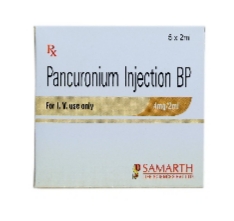
PANCURONIUM 4mg/2ml Price
Active Substance: Pancuronium bromide.
Overview
Welcome to Dwaey, specifically on PANCURONIUM 4mg/2ml page.
This medicine contains an important and useful components, as it consists of
Pancuronium bromideis available in the market in concentration
Name
Pancuronium Bromide
Precaution
Myasthenia gravis; severe electrolyte disorders; severe CV disease; pregnancy. Hepatic and renal function impairment. Hypothermia; jaundice; hypermagnesaemia, hypocalcaemia, hypokalaemia, hypoproteinaemia, acidosis, alkalosis, hypercalcemia. In obese patients, dose should be based on ideal body wt. Elderly; previous anaphylactic reactions to other neuromuscular-blocking agents. Burn patients (>30% of body) may be resistant to action for 5-70 days after injury. Demyelinating lesions, peripheral neuropathies, denervation, infection, muscle trauma, and DM may antagonise the neuromuscular blockade effects of drug. Neuromuscular diseases, acute intermittent porphyria, Eaton-Lambert syndrome. Maintain adequate airway and respiratory support during use. Lactation: not known if excreted in breast milk; effect on nursing infant not known
Indication
Adjunct to GA for Endotracheal intubation and to provide skeletal muscle ralaxation.
Contra indication
Anuria. Relatively contraindicated in conditions of reduced airway control. Lactation.
Side Effect
Tachycardia may occur due to vagal blockade and especially during light anaesthesia. May decrease intra-ocular pressure and induce miosis; excessive salivation; transient rashes and itching; wheezing; elevation in pulse rate, BP, cardiac output; erythema; burning sensation along vein; profound muscle weakness; bronchospasm; hypersensitivity reaction; acute quadriplegic myopathy syndrome, myositis ossificans. Potentially Fatal: Rare anaphylactoid reactions; bradycardia, bronchospasm, hypotension and CV collapse; respiratory depression.
Pregnancy Category ID
3
Mode of Action
Pancuronium bromide is a non-depolarising neuromuscular blocking agent with curarimimetic action through competitive blockade at the myoneural junction by binding with cholinergic receptor sites.
Interaction
Neuroleptanalgaesia may decrease neuromuscular activity. Action may be prolonged and/or potentiated by aminoglycoside antibiotics, lithium, diazepam, lidocaine (high dose), quinidine, tetracyclines, propranolol, thiamine (high dose), parenteral magnesium sulphate, MAOIs, quinine, protamine, carbamazepine, donepezil and phenytoin (if pancuronium is given concurrently for <1 wk). Action may be decreased by neostigmine, edrophonium, high-dose or long term corticosteroids, adrenaline (may also potentiate effect), azathioprine, theophylline (high doses), clindamycin, nifedipine, piperacillin, polymixins, verapamil, procainamide. Furosemide may increase or decrease effects. TCAs may increase risk of arrhythmias and hypotension during anaesthesia. Potentially Fatal: Potentiated by volatile anaesthetics (isoflurane and enflurane) and local anaesthetics. Prior admin of suxamethonium can increase the intensity of neuromuscular block. Concomitant use with digoxin may increase risk of serious cardiac arrhythmias.
Pregnancy Category Note
Information not available
Adult Dose
Child Dose
Renal Dose
Administration
